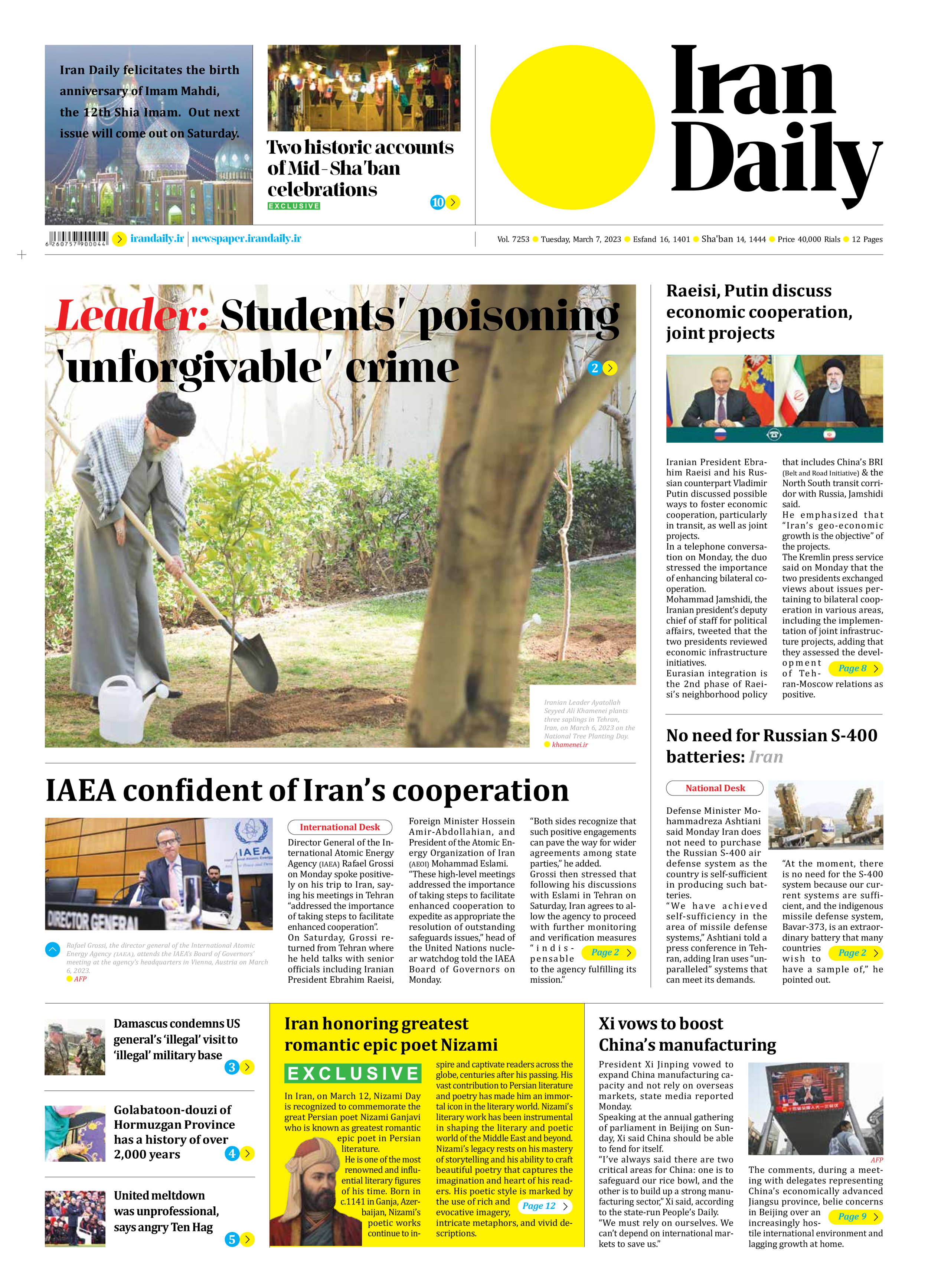
Iran honoring greatest romantic epic poet Nizami
In Iran, on March 12, Nizami Day is recognized to commemorate the great Persian poet Nizami Ganjavi who is known as greatest romantic epic poet in Persian literature.
He is one of the most renowned and influential literary figures of his time. Born in c.1141 in Ganja, Azerbaijan, Nizami’s poetic works continue to inspire and captivate readers across the globe, centuries after his passing. His vast contribution to Persian literature and poetry has made him an immortal icon in the literary world. Nizami’s literary work has been instrumental in shaping the literary and poetic world of the Middle East and beyond.
Nizami’s legacy rests on his mastery of storytelling and his ability to craft beautiful poetry that captures the imagination and heart of his readers. His poetic style is marked by the use of rich and evocative imagery, intricate metaphors, and vivid descriptions.
His works transcend time, space, and culture, and his poetry is an embodiment of the human experience, with themes ranging from love and beauty to spirituality and the divine.
Iran’s Ministry of Culture and Islamic Guidance organized a weeklong program to commemorate the Persian poet.
The program, which has been set up as a hybrid event with virtual and live meetings, began on March 5 and will continue until March 12.
Nasser Kanaani, the spokesman of the Ministry of Foreign Affairs, on the first day of the program said that honoring poets and writers is honoring human values.
He added the Persian language is the language of love, mysticism, and friendship, and Nizami has a unique position in this.
He emphasized that Nizami is a lover who has patriotism, and in this sense, he is rare, and he has expressed his love for Iran in his book ‘Haft Peykar’ which is also known as Baharnameh.
Referring to the military fame in other countries, he clarified that the Iranian poet has several admirers in Afghanistan, Tajikistan, Uzbekistan, and Azerbaijan.
During the ceremony, Secretary General of ECO Khosro Nazeri said that honoring such personalities preserves attention and interest towards cultural treasures.
Poetry knows no boundaries and brings people closer to each other, he added.
He pointed out, “Poetry, by evoking emotions, is like a bridge that eliminates cultural and economic differences.”
Nazeri also pointed to the importance of cultural diplomacy and said that cultural diplomacy plays an effective role at the regional and international level through the exchange of art and literature.
Chairman of Iran’s Association of Cultural Works and Elites also described Nizami as a common chapter in cultural ties between Iran, neighbors and Farsi-speaking countries.
“Nizami matters for the Iranians and people in the world as a common need and an element of cultural unity,” said Mahmoud Shalouei.
Nizami is highly known for ‘Khamseh’ (Quintet), a collection of five long narrative poems that he wrote between 1188 and 1197, with a total of 30,000 couplets.
Two copies of ‘Khamseh’ are preserved in Iran were inscribed on UNESCO’s Memory of the World Register list in 2011.
These five poems include the didactic work Makhzan ol-Asrar (The Treasury of Mysteries); the three traditional love stories of Khosrow and Shirin, Leili and Majnun, and Haft Peykar; and the Eskandarnameh, which records the adventures of Alexander the Great. Each of these works is a masterpiece of Persian literature, and each contributes to the literary world in its unique way.
Makhzan ol-Asrar (The Treasury of Mysteries) is a philosophical work that explores the themes of divine love and the unity of being. It is a collection of mystical poems that reflect Nizami’s deep spiritual insight and his understanding of the nature of reality. The work is marked by its exquisite language, rich imagery, and profound insights into the human soul.
Khosrow and Shirin is a romantic epic that tells the story of the love between Khosraw, the king of Iran, and Shirin, a beautiful Armenian princess. The work is a testament to Nizami’s mastery of storytelling, as he weaves together a complex narrative that combines romance, tragedy, and political intrigue. The work has been adapted into various languages and remains a popular source of inspiration for artists and writers around the world.
Leili and Majnun is another romantic epic that tells the story of the tragic love between Layla and Majnun. The work is a classic of Persian literature and has been adapted into various forms, including opera and ballet. The story has captured the imagination of readers and audiences for centuries, and its themes of love and longing continue to resonate with readers today.
Haft Peykar is a work of historical fiction that tells the story of Bahram Gur, a Sassanid king who falls in love with seven princesses. The work is a commentary on the virtues and vices of rulership and is marked by its rich symbolism and intricate imagery.
Eskandarnameh is a historical epic that tells the story of Alexander the Great’s conquests. The work is notable for its detailed descriptions of ancient Persia and its depiction of the character of Alexander. The work is also notable for its philosophical and moral themes, as it explores the nature of power and the human quest for knowledge and understanding.
Nizami’s influence on Persian literature and poetry is immense, and his works have inspired generations of poets and writers.







